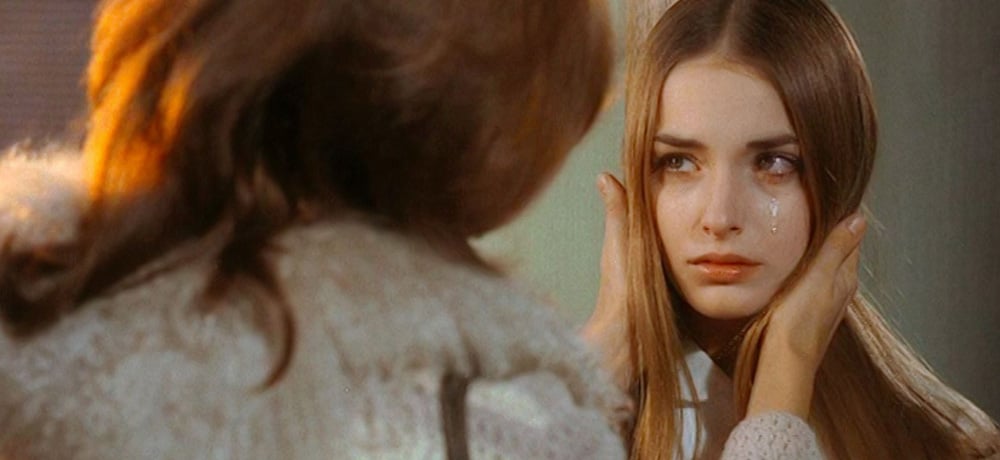


[This October is "Gialloween" on Daily Dead, as we celebrate the Halloween season by diving into the macabre mysteries, creepy kills, and eccentric characters found in some of our favorite giallo films! Keep checking back on Daily Dead this month for more retrospectives on classic, cult, and altogether unforgettable gialli, and visit our online hub to catch up on all of our Gialloween special features!]
“I’m mad, don’t forget it.”
Rossano Brazzi’s Psychout for Murder feels like an off choice to be writing about for Gialloween. While the marketing of this classic ’60s Italian thriller wants you to expect a piece of giallo, it feels incredibly different and unique in many ways. It can’t be characterized as a murder mystery of gruesome horrors. It’s not suspenseful or shocking even. There is murder, but the way these crimes are executed is much more satisfying and clever than a knife in hand could create. There are no slit throats, no gushes of blood, no one hung bloodied from a ceiling. It’s a psychological thriller of social significance, a symbol of the Swinging Sixties and women’s liberation.
The viewer is greeted with a sensual, sexy opening. A beautiful woman’s features are accentuated as she traces her hand across her lover’s body. A catchy pop song with the words “kill them” in the chorus is the soundtrack to their lovemaking. This opening number is very telling of what is to come: a film about women who make powerful men, who are ruined by them and then ruin them in turn.
This introduction to lovebirds Licia (Adrienne Larussa) and Mario (Nino Castelnuovo) takes place in a bordello, but it’s all a setup. Police raid the bordello and the photographer Mario snaps some embarrassing photos of Licia that he uses to blackmail her industrialist father (played by Brazzi himself) for $20 million. Mario’s hatched plan succeeds, and Licia is betrayed. Paying Mario off isn’t enough for her father, however. His power and reputation must be maintained. To make everyone forget about this scandal quickly, he and the rest of Licia’s family convince the press that she’s sick, committing her to an asylum. They couldn’t have predicted that being locked away would produce the insanity they projected onto her. She’s released with a sadistic plan for revenge.
The effects of years spent locked away manifest as quickly as the revenge begins. You can tell with even the slightest change in expression that Licia is containing immense rage. This is reflected by a burst of behavior that is made to feel erratic, as though it’s unnatural. Throwing flowers and running wild, she’s a woman who exudes freedom during an era of flower power and women’s liberation. In these moments it shows how good of an actress Larussa is, who resembles a modern star like Margot Robbie. Larussa hides Licia’s pain with loud laughter and playfulness, but it’s all a guise. While her revenge does feature murder—although of a much cleaner kind than giallos are known for—the emphasis is really on punishment and mental suffering. She teases and plays with her victims like toys, throwing them around just as they did with her.
She plays tricks, mind games, creating an environment so toxic it drives everyone insane. She’s a mastermind in how she stages the act, and she makes her father’s mansion where they all reside into a haunted house of sorts. Not one with real ghosts, but one that’s staged with props and effects. A string placed to mysteriously open and close that door over here, while voices echo aloud over there. She’s also incredibly seductive, driving men like Mario and her sister Giovanna’s (Paola Pitagora) husband, Francesco (Alberto de Mendoza), crazy with lust, which results in exactly what she intends: to punish them and everyone else she once loved. She wants everyone to be haunted by their mistakes, and as she breaks the fourth wall holding a gun, aiming it at us, she makes us haunted by her. Her ultimate goal is for the most powerful figure in her life—her father—to fear her, but also feel so lonely that he would never think to repeat the decisions that led them into this mess—a dynamic forming of equal powers where a man can no longer control her.
According to Anne Billson for The Telegraph, spotting a giallo film is quite easy: a work of detective fiction with shocking scenes of murder, stylish camerawork, and a jarring score. More often than not, the plot involves a psychotic killer who butchers women. Psychout for Murder would be a giallo impossible to spot by those standards. The only thing really similar is the stylish camerawork. Even the score is uncharacteristic, as it takes influence from French New Wave with its play on drums and piano keys that sound like something heard in a Godard picture. What makes Brazzi’s film especially unique for the subgenre is how it embodies such an iconic era. It presents a ’60s style that transcends borders, making it look like something out of Hollywood. A time especially groovy, not seen more so than in the film’s costume design of brilliant colors and patterns, and Larussa pulls it off, orange-tinted sunglass and all. She’s a Jean Shrimpton type, and as Pattie Boyd once called her, an embodiment of the British Swinging Sixties that caused a craze across many other parts of the world: “Mini-skirt, long, straight hair, and wide-eyed loveliness.”
I suppose that’s a way to describe the film itself, too: it has a loveliness to it. It’s a film that oozes sex, with attractive stars, attractive sets, attractive everything. It doesn’t make you squirm; it doesn’t make you afraid. On the contrary, it’s an empowering reflection on a continuing fight for equality and against sexism, making misogyny take the bullet.
---------
Keep an eye on our online hub throughout October for more of our Gialloween retrospectives!